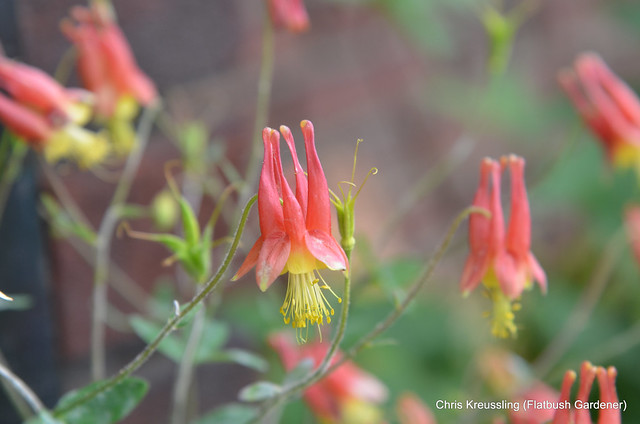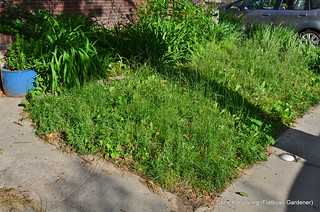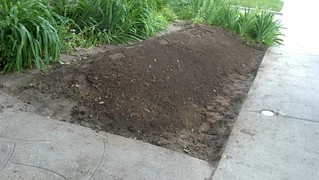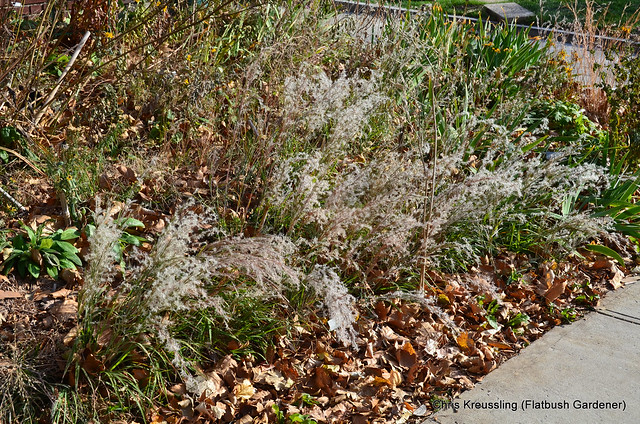Showing posts with label Ecology. Show all posts
Showing posts with label Ecology. Show all posts
2021-02-04
2019-02-12
Charismatic Mesofauna
Over the weekend I was inspired to write a little tweet storm. I thought it would make a good blog post.

It started with a blog post by entomologist Eric Eaton, who goes by @BugEric on his blog, Twitter and other social media. Benjamin Vogt, a native plants evangelist (my word, bestowed with respect) tweeted a link, which is how it came to my attention.

It started with a blog post by entomologist Eric Eaton, who goes by @BugEric on his blog, Twitter and other social media. Benjamin Vogt, a native plants evangelist (my word, bestowed with respect) tweeted a link, which is how it came to my attention.
The Monarch is the Giant Panda of invertebrates. It has a lobby built of organizations that stand to lose money unless they can manufacture repeated crises. Well-intentioned as they are, they are siphoning funding away from efforts to conserve other invertebrate species that are at far greater risk. The Monarch is not going extinct.
- Bug Eric: Stop Saying the Monarch is a "Gateway Species" for an Appreciation of Other Insects
2016-08-07
A milkweed by an other name ...
What's in a name? that which we call a rose
By any other name would smell as sweet;
- Juliet, Romeo and Juliet, Wiliam Shakespeare
A rose is a rose is a rose is a rose.I started to get into a little tiffle on a post (since removed) on one of the insect ID groups in Facebook. The original poster was trying to ID a tight cluster of orange eggs on a leaf of a plant she identified as "milkweed vine." One of the responders commented: "Milkweed vine? Not likely." And then we were off.
- Gertrude Stein, various
2015-05-09
Garden Deeper
I had a visceral (in a good way) reaction to Adrian Higgins' writeup of a visit, with Claudia West, to Shenk's Ferry Wildflower Preserve.
I think I'll adopt "ecological horticulturist" to describe my own approach to gardening. Whether you specialize in gardening with native plants, as I do, or prefer to grow plants from around the world, studying their native habitats is, in my experience, the best way to learn how to grow them in a garden.
That doesn't mean you have to recreate the conditions exactly. In many cases, this is impossible, anyway. The native Aquilegia canadensis, eastern red columbine, thrives in the crumbling mortar of my front steps; this location recreates some aspects of the face of a limestone cliff where I saw, decades ago, a huge colony of them in full bloom.

This is why I'm trying to go on more botanical walks and hikes. Like many, if not most, gardeners, I've never seen most of the plants I grow in the wild. I visited Hempstead Plains for the first time in August 2013.

That inspired me last year to remove most of the remaining lawn in the front yard and approach it as a meadow, instead.





Rain gardens and rock gardens are both examples of creating gardens to grow plants requiring specific conditions, and to meet human needs. But we don't need to go to so much trouble. For all the "problem areas" in our gardens, there are plants that want nearly exactly those conditions. We need only think like a plant to see these as opportunities, and embrace the habitats waiting to emerge.
I think I'll adopt "ecological horticulturist" to describe my own approach to gardening. Whether you specialize in gardening with native plants, as I do, or prefer to grow plants from around the world, studying their native habitats is, in my experience, the best way to learn how to grow them in a garden.
That doesn't mean you have to recreate the conditions exactly. In many cases, this is impossible, anyway. The native Aquilegia canadensis, eastern red columbine, thrives in the crumbling mortar of my front steps; this location recreates some aspects of the face of a limestone cliff where I saw, decades ago, a huge colony of them in full bloom.

This is why I'm trying to go on more botanical walks and hikes. Like many, if not most, gardeners, I've never seen most of the plants I grow in the wild. I visited Hempstead Plains for the first time in August 2013.

That inspired me last year to remove most of the remaining lawn in the front yard and approach it as a meadow, instead.





Rain gardens and rock gardens are both examples of creating gardens to grow plants requiring specific conditions, and to meet human needs. But we don't need to go to so much trouble. For all the "problem areas" in our gardens, there are plants that want nearly exactly those conditions. We need only think like a plant to see these as opportunities, and embrace the habitats waiting to emerge.
Related Content
Hempstead Plains, Long Island's Remnant Prairie, 2013--09-04
Links
What you can learn from a walk through the woods (with Claudia West), Adrian Higgins, Washington Post Home & Garden2015-04-26
Pine Barrens Soil Horizons
Yesterday, I transplanted a small piece of Carex pensylvanica, Pennsylvania sedge, from my sister's property in Ocean County, New Jersey. This species is common on her property.
She lives in the pinelands of New Jersey. The canopy is pine and oak. The duff layer - the natural "mulch" of dead plant material deposited on top of the soil - is composed of mostly pine needles, with some oak leaves.
Here's a view of the clump I extracted.
She lives in the pinelands of New Jersey. The canopy is pine and oak. The duff layer - the natural "mulch" of dead plant material deposited on top of the soil - is composed of mostly pine needles, with some oak leaves.
Here's a view of the clump I extracted.
2015-02-20
Pollinator Gardens, for Schools and Others
I got a query from a reader:
I’m working on a school garden project and we’d like to develop a pollinator garden in several raised beds. Can you recommend some native plants that we should have in our garden? Ideally we’d like to have some perennials and maybe a few anchor bushes. Are there any flowers that we might be able to start inside this spring then transplant? Also, because the students will be observing the pollinators, butterfly attracting plants are preferable to the teachers.Whole books have been written on this topic, but here are some quick thoughts and references for further research.
2014-08-10
Megachile, Leaf-Cutter Bees
A leaf-cutter bee removes a segment from a leaf of Rhododendron viscosum, swamp azalea, in my urban backyard native plant garden and wildlife habitat (National Wildlife Federation Certified Wildlife Habitat #141,173). You can see other segments - both completed and interrupted - on the same and adjacent leaves.
Like carpenter bees, Leaf-cutters are solitary bees that outfit their nests in tunnels in wood. Unlike carpenter bees, they're unable to chew out their own tunnels, and so rely on existing ones. This year, I've observed a large leaf-cutter - yet to be identified - reusing a tunnel bored in previous years by the large Eastern carpenter bee, Xylocopa virginica.
They use the leaf segments to line the tunnels. The leaves of every native woody plant in my garden has many of these arcs cut from the leaves. The sizes of the arcs range widely, from dine-sized down to pencil-points, reflecting the different sizes of the bee species responsible.
Tiny arcs cut from the leaves of Wisteria frutescens in my backyard.
I speculate that different species of bees associate with different species of plants in my gardens. The thickness and texture of the leaves, their moisture content, and their chemical composition must all play a part. I've yet to locate any research on this; research, that is, that's not locked up behind a paywall by the scam that passes for most of scientific publishing.
Although I've observed the "damage" on leaves in my garden for years, this was the first time I witnessed the behavior. Even standing in the full sun, I got chills all over my body. I recognize now that the "bees with big green butts" I've seen flying around, but unable to observe closely, let alone capture in a photograph, have been leaf-cutter bees.
As a group, they're most easily identified by another difference: they carry pollen on the underside of their abdomen. A bee that has pollen, or fuzzy hairs, there will be a leaf-cutter bee.
An unidentified Megachile, leaf-cutter bee, I found in my garden.
Another behavior I observe among the leaf-cutters in my garden is that they tend to hold their abdomens above the line of their body, rather than below, as with other bees. Perhaps this is a behavioral adaptation to protect the pollen they collect. In any case, when I see a "bee with a perky butt," I know it's a leaf-cutter bee.
When they're not collecting leaves, they're collecting pollen. Having patches of different plant species that bloom at different times of the year is crucial to providing a continuous supply of food for both the adults and their young.
An individual bee will visit different plant species (yes, I follow them to see what they're doing). And different leaf-cutter species prefer different flowers. All the plants I've observed them visit share a common trait: they have tight clusters of flowers holding many small flowers; large, showy flowers hold no interest for the leaf-cutter bees.
Like carpenter bees, Leaf-cutters are solitary bees that outfit their nests in tunnels in wood. Unlike carpenter bees, they're unable to chew out their own tunnels, and so rely on existing ones. This year, I've observed a large leaf-cutter - yet to be identified - reusing a tunnel bored in previous years by the large Eastern carpenter bee, Xylocopa virginica.
They use the leaf segments to line the tunnels. The leaves of every native woody plant in my garden has many of these arcs cut from the leaves. The sizes of the arcs range widely, from dine-sized down to pencil-points, reflecting the different sizes of the bee species responsible.
Tiny arcs cut from the leaves of Wisteria frutescens in my backyard.
I speculate that different species of bees associate with different species of plants in my gardens. The thickness and texture of the leaves, their moisture content, and their chemical composition must all play a part. I've yet to locate any research on this; research, that is, that's not locked up behind a paywall by the scam that passes for most of scientific publishing.
Although I've observed the "damage" on leaves in my garden for years, this was the first time I witnessed the behavior. Even standing in the full sun, I got chills all over my body. I recognize now that the "bees with big green butts" I've seen flying around, but unable to observe closely, let alone capture in a photograph, have been leaf-cutter bees.
As a group, they're most easily identified by another difference: they carry pollen on the underside of their abdomen. A bee that has pollen, or fuzzy hairs, there will be a leaf-cutter bee.
An unidentified Megachile, leaf-cutter bee, I found in my garden.
Another behavior I observe among the leaf-cutters in my garden is that they tend to hold their abdomens above the line of their body, rather than below, as with other bees. Perhaps this is a behavioral adaptation to protect the pollen they collect. In any case, when I see a "bee with a perky butt," I know it's a leaf-cutter bee.
When they're not collecting leaves, they're collecting pollen. Having patches of different plant species that bloom at different times of the year is crucial to providing a continuous supply of food for both the adults and their young.
An individual bee will visit different plant species (yes, I follow them to see what they're doing). And different leaf-cutter species prefer different flowers. All the plants I've observed them visit share a common trait: they have tight clusters of flowers holding many small flowers; large, showy flowers hold no interest for the leaf-cutter bees.
Related Content
Links
BugGuide: Genus Megachile2012-08-27
A Hudson River Riparian Plant Community
Part of the eastern bank of the Hudson River, just south of the Route 8 bridge at Riparius/Riverside in the Adirondacks of New York. A year ago, this was all underwater, inundated by flood waters from Hurricane Irene.


Labels:
2012,
Adirondacks,
August,
Botany,
Ecology,
Hudson River,
Hurricane,
New York,
Photos,
Riparius,
Riverside
Location:
Riparius, Chester, NY 12817, USA
Subscribe to:
Posts (Atom)
